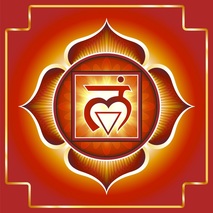Swirling, expanding and contracting, a column of energetic wheels aligned from the base of our spine to the crown of our head, the chakras pulse as centers of spiritual power in the human body.

Chakra is a Sanskrit word meaning wheel, circle, or disc. The fine network of energetic lines called nadis that run through our body meet at these 7 colorful centers making up a rainbow spectrum. The Chakras regulate all functions of our body and energy systems.

How can we become more aware of these mysterious power centers within us? The answer may come with the natural state of being that the yoga practice brings us.
Once the mind reaches a point of stillness, we are able to realize these pulsating, light filled spinning wheels.
Because of the infinite nature of our inner being, it’s said that each chakra contains lokas, or worlds, and are inhabited by devatas, or deities.
Here’s some more insight into each chakra, what they represent & govern.


The seventh chakra, sahasrara, floats above the crown of the head. Often referred to as a thousand-petaled lotus, it is said to be the most subtle in the chakra system, and is related to pure consciousness, our connection to Divinity.

The sixth chakra, ajna, is located at the third eye. It is associated with the color violet or indigo, and with higher knowledge, the subtle aspects of sight, and with intuition. It is associated with the syllable “OM”.

The fifth chakra, vishuddha, is located in the throat. It is associated with the color pale blue or turquoise. Vishuddha means “very pure.” It is associated with the element “ether,” and is related to your ability to speak truth, express ideas clearly, and be attuned to inner and outer vibrations. It is associated with the syllable “HAM”.

The fourth chakra, anahata, is located at the heart center. It is associated with the color green, and its name references an “unstruck chord”, or unbeaten. It is represented by a lotus flower with twelve petals. The seed sound is “YAM”. It is associated with the element air.

The third chakra, manipura, is located in the solar plexus/navel area. It is associated with the color yellow and the syllable “RAM”. It is often translated as “city of jewels.” This chakra is associated with fire and the power of transformation.

The second chakra, svadhishthana, is located in the sacral area. It is associated with the color vermillion or orange, and the sound “VAM”. It is connected with the sense of taste, and with reproduction.

The base chakra, muladhara, is also called the root chakra, and is located just above the pelvic floor. It is associated with the sense of smell, and represents earthly grounding The color is red, and the seed syllable is “LAM”.
When practicing asana, each posture has an affect on the chakras to help bring about balance and the ability to fully use your intuition, imagination, wisdom, knowledge, and inner powers. One example is sirshasana, or headstand, which stimulates the sahasrara chakra at the crown of your head to enhance clarity of vision, intuition, and your connection to Divinity.

How can we go about our lives with an awareness of our energetic bodies and their functions? The yoga practice offers many methods to balance, activate, or visualize the chakras, One way is by simply chanting the bija mantra, sanskrit for seed, associated with each chakra. The bija mantras are one-syllable sounds that, when said aloud, activate the energy of the chakras in order to purify & balance the mind & body. Try it! Repeat the mantra below visualizing each chakra starting with the base or root chakra, the muladhara, working your way up to the crown chakra. The a is pronounced with an ah sound:
LAM
VAM
RAM
YAM
HAM
OM
a moment of silence…
get a rhythm going & repeat as many times as you like!

The 7 major chakras also interact with our body through the endocrine system (a seven gland system) which is one of the body’s main control mechanisms. The endocrine system produces the hormones that stimulate or inhibit physiological processes. How does a change in our consciousness does affect our physical body?

Crown chakra (Sahasrara, color violet): pineal gland – spirituality and divine awareness.
Third eye chakra(Ajna, color indigo): between eyebrows, pituitary gland, intuition.
Throat chakra(Vishuddhi, color blue): throat area, thyroid, communication and self-expression.
Heart chakra (Anahata, color green): heart area, thymus, compassion, love, and healing.
Solar plexus chakra (Manipura, color yellow): navel area, pancreas, self will, self esteem, courage, and personal power.
Sacral chakra (Svadhisthana, color orange): genital area, ovaries, creativity, emotion and sensuality.
Root chakra (Muladhara, color red): base of the spine, gonads, safety and survival, sense of belonging.
The heart is the hub of all sacred places. Go there, and roam.
– Bhagawan Nityananda
